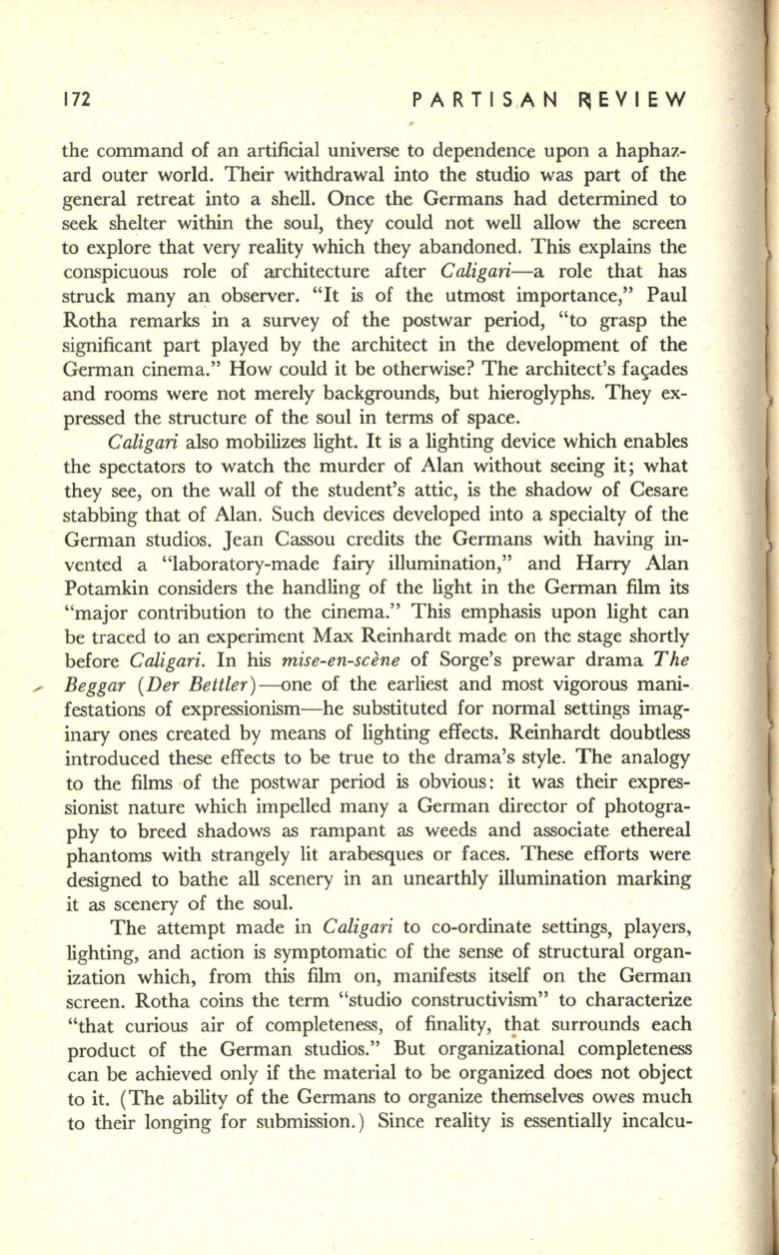
172
PART I S,A
N
~
EVIEW
the command of an artificial universe to dependence upon a haphaz–
ard outer world. Their withdrawal into the studio was part of the
general retreat into a shell. Once the Germans had determined to
seek shelter within the soul, they could not well allow the screen
to explore that very reality which they abandoned. This explains the
conspicuous role of architecture after
Caligari-a
role that has
struck many at?- observer. "It is of the utmost importance," Paul
Rotha remarks in a survey of the postwar period, "to grasp the
significant part played by the architect in the development of the
German cinema." How could it be otherwise? The architect's fac;ades
and rooms were not merely backgrounds, but hieroglyphs. They ex–
pressed the structure of the soul in terms of space.
Caligari
also mobilizes light. It is a lighting device which enables
the spectators to watch the murder of Alan without seeing it; what
they see, on the wall of the student's attic, is the shadow of Cesare
stabbing that of Alan. Such devices developed into a specialty of the
German studios. Jean Cassou credits the Germans with having in–
vented a "laboratory-made fairy illumination," and Harry Alan
Potamkin considers the handling of the light in the German film its
"major contribution to the cinema." This emphasis upon light can
be traced to an experiment Max Reinhardt made on the stage shortly
before
Caligari.
In his
mise-en-scene
of Sorge's prewar drama
The
.,.
Beggar (Der Bettler)-one
of the earliest and most vigorous mani-.
festations of expressionism-he substituted for normal settings imag–
inary ones created by means of lighting effects. Reinhardt doubtless
introduced these effects to be true to the drama's style. The analogy
to the films of the postwar period is obvious: it was their expres–
sionist nature which impelled many a German director of photogra–
phy to breed shadows as rampant as weeds and associate ethereal
phantoms with strangely lit arabesques or faces. These efforts were
designed to bathe all scenery in an unearthly illumination marking
it as scenery of the soul.
The attempt made in
Caligari
to co-ordinate settings, players,
lighting, and action is symptomatic of the sense of structural organ–
ization which, from this film on, manifests itself on the German
screen. Rotha coins the term "studio constructivism" to characterize
"that curious air of completeness, of finality, that surrounds each
product of the German studios." But organizational completeness
can be achieved only if the material to be organized does not object
to it. (The ability of the Germans to organize themselves owes much
to their longing for submission.) Since reality is essentially incalcu-
~


